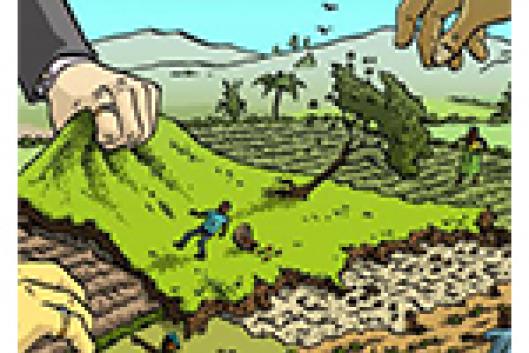For decades, governments and intergovernmental agencies like the UN or the World Bank have been busy finding ways to allow the flow of large investments and projects to go on – no matter the consequences. Despite fossil fuels being the main cause of climate change, we see oil, coal and gas companies expanding extraction activities. Despite land clearance for industrial agriculture being one of the main causes of deforestation, we see agribusinesses increasing tree and crop monocultures. We also see the mining industry going deeper into the Earth. We see more roads, railways, pipelines, ports and other major infrastructure projects that facilitate the extraction and commercialization of “natural resources”. And as a consequence of this, we see thousands of communities being dispossessed of their homes, livelihoods, cultures, territories and even people losing their lives. Ironically, these same industries can continue their destruction while claiming now that they are “green” or “certified”, “climate neutral” or “sustainable”.
But in spite of the nice wording, the dominant economic system has been and continues to be violent. It is violent with nature and therefore it is violent with the people that coexist with and depend on it. This is inherited in the system’s necessity of constant growth and accumulation, even when the Earth’s “resources” are finite. In this context, governments, corporations and financial backers have been promoting a “new” economy: an “economy with nature” that allows business to compensate for their pollution or biodiversity destruction. A company that wants to extract minerals lying under a forest would be able to do so and claim no damage is done to the diversity of the forest as long as the biodiversity that is destroyed is compensated by preserving or restoring another area that should be “equivalent” to the one destroyed. Likewise, an oil refinery can continue to pollute above any target as long as elsewhere a project is avoiding or saving an “equivalent” amount of emissions. Behind the compensations, hundreds of brokers, consultancy firms, NGOs, certification schemes and financial agencies are profiting from these transactions. As a consequence, the dominant economic system is reinforced and can continue growing.
In this way, power relations, injustices, dispossessions and violence are being hidden behind measurements and numbers. Transforming “nature” into quantifiable units for compensating its destruction is allowing companies and governments to have further access and control over more and more territories. The idea of compensating the devastation of a specific place in a specific time, with specific living inter-connections, communities and histories is absurd. To make things worse, this “economy with nature” also tends to portray forest and peasant communities as the ones to blame for the destruction of “nature”. Traditional cultivation methods are being demonized, and even forbidden in some places, for supposedly being a source of large-scale deforestation. Meanwhile, large investments are off the hook of any responsibility while promoting with expensive campaigns how good they are for the climate and the forests.
During this year, and in order to learn more about how the “economy with nature” manifests itself in and for forest and peasant communities around the world, we included a series of articles in our monthly bulletins that try to shed some light on this trend. We ask: what does the “economy of nature” imply to the struggles to protect forest and peasant territories? How could we resist this trend? As the end of the year approaches, we want to share a compilation of the articles related to this trend with the hope that we can keep learning together and therefore strengthen our analysis and resistance.
WRM International Secretariat
